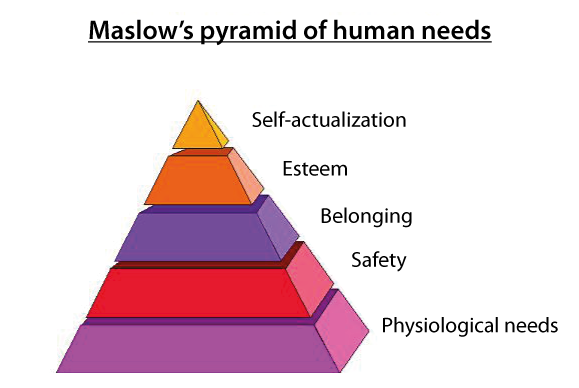Lean Manufacturing and the Kaizen philosophy of continuous improvement are based on work groups. It is not possible to implement WCM or TPM if we are unable to manage and promote teamwork.
What are the base conditions that a good Kaizen coach must create so that the group performs very well?
In order to answer this question we can avail ourselves of Maslow’s famous pyramid of human needs.
According to this pyramid every human being tries to satisfy 8 types of primary needs.
Maslow has discovered that the human being tries to satisfy his needs in degrees.
When he is sure that he has satisfied a need, that is when the need to act to satisfy the next one appears and this dynamic continues until self-actualization is achieved. A work group progresses towards high performance by following the same dynamics.
 In order for a group to “perform” at their best it is necessary that all 8 needs of the pyramid be met one after the other, otherwise the individuals will not be comfortable in the group and will try to run from it.
In order for a group to “perform” at their best it is necessary that all 8 needs of the pyramid be met one after the other, otherwise the individuals will not be comfortable in the group and will try to run from it.
These problems can be corrected, through active listening of the members of the group. The checklist below can be used to identify and understand where the discomfort of the group members is and correct it.
This checklist can also be used as an indicator to measure the progression of the amalgamation of the group.
1) Physiological Needs (Nourishment, sleep, clothing, etc.)
The dissatisfaction of the physiological needs leads to fear of telling the truth.
The members of a group that works well think:
- In the group I can tell the truth and say what I think without running the risk of being penalized in my career.
- The attitude of the group is that of trying to find the truth of the facts always and no matter what.
2) Safety Needs
The dissatisfaction of the safety need can place spontaneity at risk.
The members of a group that works well think:
- If I make a mistake or say something wrong I feel safe and I am accepted nonetheless.
3) Safety Needs
The dissatisfaction of the safety need, can place the feeling of being able to act, influence and control at risk.
The members of a group that works well think:
- In the group I feel in control of myself, I feel I can influence others with my ideas.
- I take and express my responsibilities.
- I feel that others can count on me and I can count on others
- I feel sufficiently strong and safe to be able to reveal to the other members the weaknesses I see in the group.
4) Belonging Needs
The dissatisfaction of the belonging need leads to the fear of being excluded
The members of a group that works well think:
- I feel included in the group.
- I see the others in the group seek me out so that I can participate in the activities.
- Within the group I have a role to carry out and with which I can contribute.
5) Belonging Needs
The dissatisfaction of the belonging need leads to the fear of not feeling well emotionally in the group.
The members of a group that works well think:
- I feel I am liked by the other members of the group.
- I am happy with myself as a member of the group.
- I like the other members of the group.
- Participating in the group is fun, we laugh a great deal.
6) Belonging Needs
The dissatisfaction of the belonging need leads to the fear of not being able to collaborate with the others.
The members of a group that works well think:
- In the group we work well with each other.
- In the group we do things well and efficiently.
- We communicate well to coordinate activities.
- If there is conflict, we work calmly to resolve it.
7) Esteem Needs
The dissatisfaction of the esteem need leads to the fear of not being: respected, honored and important.
The members of a group that works well think:
- I feel that in the group I have meaning, I feel respected and honored.
8) Self-actualization needs
The dissatisfaction of the self-actualization need leads to the fear of not performing well.
The members of a group that works well think:
- The group and its activities motivate me to go beyond my abilities and my standards.
- We have many more opportunities to be creative working in the group rather than individually.
- The group on the whole is much more intelligent than the single individuals.
Analyzing this checklist, it is possible to understand why it is so difficult and stressful (for those who are not familiar with coaching) to achieve the so-called Kaizen weeks.
The members of a group are not always selected based on their psychological characteristics and their levels of needs satisfaction, for this reason the possibility for conflict and dissatisfaction is always high.
For those who speak English, an excellent book for learning about group coaching is:
Title: “Group and Team Coaching”
Author: L. Michael Hall
Mario Mason
Kaizen Coach






